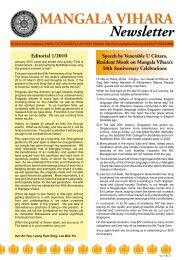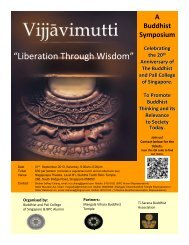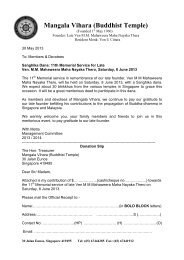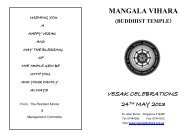Pre-Buddhist Indian Thought - Home Page of Mangala Vihara ...
Pre-Buddhist Indian Thought - Home Page of Mangala Vihara ...
Pre-Buddhist Indian Thought - Home Page of Mangala Vihara ...
Create successful ePaper yourself
Turn your PDF publications into a flip-book with our unique Google optimized e-Paper software.
BPFE-101: <strong>Pre</strong>-<strong>Buddhist</strong> <strong>Indian</strong> <strong>Thought</strong><br />
A general knowledge <strong>of</strong> the major philosophical tendencies in pre-<strong>Buddhist</strong> India with a<br />
greater emphasis on the following topics is expected here.<br />
Vedic hymns and their philosophical import; the nature <strong>of</strong> the Vedic concept <strong>of</strong> god;<br />
Vedis attitude towards speculation and criticism; Vedic cosmology; Vedic analysis <strong>of</strong> the<br />
relationship between the world and the Absolute Vedic conceptions <strong>of</strong> Kamma and<br />
rebirth; Upanisadic critique <strong>of</strong> the Vedic philosophy; Upanisadic view <strong>of</strong> reason , doubt,<br />
metaphysical theories and the means <strong>of</strong> knowledge; the Upanisadic concepts <strong>of</strong> Aunan<br />
and Brahman; ethical and psychological teachings in the Upanisads; materialist schools<br />
and their teachings; the means <strong>of</strong> knowledge accepted be materialists ; a general<br />
knowledge <strong>of</strong> Sankya,Yoga and Nyaya philosophies; skeptical interpretations <strong>of</strong> the logic<br />
<strong>of</strong> four alternatives; Jainism and Ajivikism; Syadvada <strong>of</strong> the Jains; Jain analysis <strong>of</strong><br />
Reason and Knowledge; the psychological and metaphysical views <strong>of</strong> the Jains; Four-fold<br />
restraint ( Catuyamasamvara) and the theory <strong>of</strong> annihilating the Kamma<br />
( Kammakkhayavada) ; the causal theory <strong>of</strong> Ajivikas; Ajivika view on reason, mystical<br />
intuition and tradition ; the Trairasika Ajivikas.<br />
RECOMMENDED READING:<br />
1. A History <strong>of</strong> <strong>Indian</strong> Buddhism , S.R.Goyal ,Kusumanjali Prakasan Meorul – 1987<br />
2. Early <strong>Buddhist</strong> Theory <strong>of</strong> Knowledge , K.N. Jayatilake, Motilal Banarsidas, Delhi<br />
, 1980<br />
3. <strong>Buddhist</strong> Philosophy , D.J. Kalupahana , Hawaii – 1976<br />
4. Development in the Early <strong>Buddhist</strong> Concept <strong>of</strong> Kamma Mc Dermott James Paul,<br />
Munshiram Manoharlal , New Delhi- 1981<br />
5. <strong>Indian</strong> Buddhism , A.K.Warder , Motilal Banarsidas, Delhi-1970<br />
BPFE 102 – Emergence <strong>of</strong> Buddhism and Basic <strong>Buddhist</strong> Teachings<br />
Religious and philosophical background and basic <strong>Buddhist</strong> teachings embodied in the<br />
Pali Canon should be studied here.<br />
1. The following topics are emphasized for the religious and philosophical<br />
background <strong>of</strong> Buddhism.<br />
<strong>Pre</strong>-<strong>Buddhist</strong> paths <strong>of</strong> emancipation and traditional means <strong>of</strong> knowledge;<br />
<strong>Pre</strong>-<strong>Buddhist</strong> teaching <strong>of</strong> Dhyana and Samapati;<br />
<strong>Pre</strong>-<strong>Buddhist</strong> beliefs in Kamma,<br />
Rebirth and the concept <strong>of</strong> soul; origin, evolution and objectives <strong>of</strong> the<br />
ascetic movement;<br />
Metaphysical and Non-empirical concepts;<br />
Six religious teachers and their life stories and philosophies;<br />
Self-indulgence and self-mortification (Kamasukhallikanuyoaga and<br />
Attakilamathanuyoga); skeptical and materialist tendencies.<br />
2. The following topics are emphasized for the basic teachings embodied in the Pali<br />
Canon.
Three characteristics <strong>of</strong> existence; four noble truths; interdependent<br />
origination;<br />
Analysis <strong>of</strong> Khanda, Dhatu and Ayatana; Kamma; rebirth;<br />
<strong>Buddhist</strong> analysis <strong>of</strong> Sasvatavada and Ucchedavada;<br />
Attention should also be paid to the <strong>Buddhist</strong> analysis <strong>of</strong> the following<br />
topics: world and its inhabitants; sense perception; psychology; ethics;<br />
reason, revelation and experience.<br />
Four fold analysis <strong>of</strong> questions and the <strong>Buddhist</strong> attitude towards language<br />
should also be studied here.<br />
RECOMMENDED READING:<br />
1. What the Buddha Taught , W Rahula, <strong>Buddhist</strong> Missionary Society, Kuala<br />
Lumpur , Malaysia – 1978<br />
2. Early <strong>Buddhist</strong> Theory Of Knowledge , K.N. Jayatilake, Motilal Banarsidas ,<br />
Delhi-1980<br />
3. Causality : The central Philosophy <strong>of</strong> Buddhism , D.J.Kalupahana, Honolulu ,<br />
The University , press <strong>of</strong> Hawai –1975<br />
4. History <strong>of</strong> <strong>Buddhist</strong> thought, E.J.Thomas , London-1953<br />
5. The Buddha’s Anicient Path , Piyadasi Thera , Taiwan-1995<br />
BCFE-101 : <strong>Pre</strong> – <strong>Buddhist</strong> <strong>Indian</strong> Culture<br />
Candidates are expected to posses a detailed knowledge on the <strong>Indian</strong> Culture from the<br />
age <strong>of</strong> the Indus Valley Civilization up to the time <strong>of</strong> the Buddha.<br />
Special focus should be in the followings:<br />
1. <strong>Indian</strong> culture before the advent <strong>of</strong> Aryans.<br />
2. Evolution <strong>of</strong> the religious , social and literary aspects <strong>of</strong> the Vedic Brahmanic<br />
Culture upto the Upanishadic<br />
3. Evolution <strong>of</strong> Sramanic culture and its characteristics<br />
4. Political, economic and social conditions during the time <strong>of</strong> the Buddha<br />
5. Nature <strong>of</strong> the Brahmanic thought during the time <strong>of</strong> the Buddha<br />
6. Teachings <strong>of</strong> the six religious teachers contemporary to the Buddha<br />
RECOMMENDED READING:<br />
1. Hinduism and Buddhism, C.Eliot, London, 1957<br />
2. The Wander That was India, A.L.Basham, London, 1957<br />
3. <strong>Indian</strong> Philosophy, Vol.1, S.Radhakrishnan, London, 1958<br />
4. History <strong>of</strong> <strong>Indian</strong> Philosophy, Vol I S.Das Gupta, Cambridge, 1963<br />
5. The Origin and the Early Development <strong>of</strong> <strong>Buddhist</strong> Monachism,<br />
Patricia Olivelle, Gunasena, Colombo, 1974<br />
6. <strong>Indian</strong> Buddhism, A.K. Warder, Delhi 1980<br />
7. Studies in the Origins <strong>of</strong> Buddism,G.C.Pande, Deihi, 1983<br />
8. Early Buddhism and Its Origins, V.P.Verma, New Delhi, 1973<br />
BCFE-102 : Origins <strong>of</strong> Buddhism and the Basic Concepts <strong>of</strong> Culture
A systematic knowledge on the early period <strong>of</strong> <strong>Buddhist</strong> civilization is expected with<br />
special emphasis on the topics given below :<br />
1. <strong>Buddhist</strong> critique <strong>of</strong> its religio-philosophic environment<br />
2. Special Characteristics <strong>of</strong> the life <strong>of</strong> the Buddha<br />
3. Fundamental teachings <strong>of</strong> Buddhism : The <strong>Buddhist</strong> theory pertaining to the nature<br />
<strong>of</strong> sentient being ; the true nature if empirical exsistence according to Buddhism ;<br />
<strong>Buddhist</strong> analysis <strong>of</strong> perception , mind and matter ; the <strong>Buddhist</strong> teaching on<br />
Critical outlook , universal love , adaptability, Democratic nature.<br />
4. Social, political and economic thought in Buddhism.<br />
RECOMMENDED READING:<br />
1. Studies in the Origin <strong>of</strong> Buddhism , G.C. Pande , Delhi ,1983<br />
2. <strong>Buddhist</strong> <strong>Thought</strong> in India, E.Conze , London , 1982<br />
3. A Theory <strong>of</strong> Causality in Early Buddhism , W.S. Karunaratne , Colombo , 1988<br />
4. <strong>Buddhist</strong> Philosophy: A Historical Analysis , D.J. Kalupahana, Honolulu , 1976.<br />
PFE.101. Introduction to Pali Grammar<br />
A general knowledge <strong>of</strong> Pali grammar necessary to understand the prose and verse<br />
written in Pali is expected in this paper. The candidates are advised to have to ability to<br />
analyze the words in Pali Language.<br />
Pali nouns, verbs , indieclinables , combinations , compounds and sentence patterns<br />
should be studied for this purpose. The competence in translating the given prose and<br />
verse passages correctly should also be acquired here.<br />
RECOMMENDED READING.<br />
1. The New Pali Course , Vol 1-2 , A.P.Buddhadatta Thera , Colombo , 1954-62<br />
2. Pali made easy , B.Ananda Maitreya Thera Japan , 1993<br />
3. A Pali Reader, Denes Andersen, Copenhagen 1935<br />
4. Pali <strong>Buddhist</strong> Texts, Rune E.A. Johanson, London, 197.<br />
PFE.102.<strong>Pre</strong>scribed Texts-1<br />
Comprehension and contents <strong>of</strong> the following texts are emphasized here. The textual<br />
contexts <strong>of</strong> the prescribed texts in relation to the Pali Canon should be recognized.<br />
The ability to translate the passages quoted from the prescribed texts grammatically with<br />
the correct meaning into English will also be examined.<br />
<strong>Pre</strong>scribed texts :<br />
Samyutanikaya - Devaputta Samyutta<br />
Anguttaranikaya - Catukkanipata<br />
Bhandagama Vagga,<br />
Cakka Vagga,<br />
Mahavagga - Mahakkhandaka,<br />
Cullavagga - Bhikkunikkhandaka
RECOMMENDED READING:<br />
1. A History <strong>of</strong> <strong>Indian</strong> Literature , Vol 2 , M.Winternitz. Motilal Banarsidas , Delhi ,<br />
1983<br />
2. A History <strong>of</strong> <strong>Indian</strong> Literature , Vol 1 B.C. Law<br />
BPGE 201 - PHILOSOPHY OF EARLY HISTORY<br />
BUDDHIST SCHOOLS<br />
A comprehensive study <strong>of</strong> the Sthaviravada and Mahasanghika schools <strong>of</strong> Buddhism<br />
which came into existence after the second council and their philosophical teachings are<br />
expected with special attention to the following subjects.<br />
The relationship between the philosophical trends in the <strong>Buddhist</strong> thought appearing in<br />
the Suttapitaka and the <strong>Buddhist</strong> thought <strong>of</strong> the early schools <strong>of</strong> Buddhism; different<br />
views <strong>of</strong> Dharmavada and their various revisions; analysis <strong>of</strong> mind and sense perception;<br />
analysis <strong>of</strong> matter and atomism; the concept <strong>of</strong> time and the theory <strong>of</strong> momentariness;<br />
analysis and synthesis <strong>of</strong> Dhamma; divisions <strong>of</strong> truths as conventional and absolute and<br />
their mutual relationship; Nibbana and its sectarian interpretations.<br />
RECOMMENDED READING<br />
Cebtral Conception <strong>of</strong> Buddhism - K. Stcherbatsky, Calcutta, 1956<br />
Early History <strong>of</strong> the Spread <strong>of</strong> Buddhism and <strong>Buddhist</strong> School - N. Dutt, New<br />
Delhi, 1980<br />
Guide Through the Abhidhamma Pitaka – Nanatiloka, Colombo, 1957<br />
<strong>Indian</strong> Buddhism - A. K. Warder, Delhi, 1980<br />
Points <strong>of</strong> Controversy (Kathavatthu) - Trs. S. Z. Aung and Mrs. Rhys Davids.<br />
London, 1958<br />
2500 Years <strong>of</strong> Buddhism - Ed. P. V. Bapat, Delhi, 1956<br />
System <strong>of</strong> <strong>Buddhist</strong> <strong>Thought</strong> - Yamakami Sogen, Calcutta, 1912<br />
BPGE 202 - PHILOSOPHY OF MAHAYANA BUDDHIST<br />
SCHOOLS<br />
A critical study <strong>of</strong> the origin, expansion and philosophy <strong>of</strong> Mahayana <strong>Buddhist</strong> schools<br />
with reference to the original sources is expected here. In this study special attention is<br />
drawn to the following topics.<br />
1. Canonical evidence <strong>of</strong> the causes that led to the emergence <strong>of</strong> Mahayana; the<br />
interpretation <strong>of</strong> the word Mahayana and the nature <strong>of</strong> its philosophy<br />
2. Origin and development <strong>of</strong> Madhyamaka philosophy; concept <strong>of</strong> Sunyata and its<br />
interpretations; Madhyamaka viewpoint <strong>of</strong> voidness; interdependent origination;
Middle path; Samsara and Nibbana; dialectical method and its adaptation; nature<br />
and realization <strong>of</strong> unconditioned realities.<br />
3. Special attention should be paid to the concepts <strong>of</strong> Trikaya, Bodhicitta,<br />
Bodhisatva pranidhana, ideal <strong>of</strong> Bodhisatva, perfections (paramita) and ten states<br />
(dasabhumi)<br />
4. The causes that led to the emergence <strong>of</strong> Yogacara vignanavada; analysis <strong>of</strong> Citta<br />
matrata and Vignanamatrata; various divisions, nature and function <strong>of</strong> vignanta<br />
and how vignana differs from cittamatrata.<br />
A general knowledge <strong>of</strong> the basic tenets and nature <strong>of</strong> Tantrayana which is an <strong>of</strong>fshort <strong>of</strong><br />
Mahayana is also expected here.<br />
RECOMMENDED READING<br />
Prajna Paramita Hrdaya Sastra (with text and notes) - Ed. E. Conze, <strong>Buddhist</strong><br />
wisdom book, 1958<br />
The Central Philosophy <strong>of</strong> Buddhism - T. R. V. Murti, London, 1955<br />
<strong>Buddhist</strong> <strong>Thought</strong> in India - E. Conze, London<br />
The Yogacara Idealism – A. K. Chaterjee, varanasi, 1975<br />
The Bodhisatva Doctrine in <strong>Buddhist</strong> Sanskrit Literature - Har Dayal, Motilal<br />
Banarsidas, Delhi<br />
Mahayana Buddhism - Nalinaksha Dutt, Mortilal Banarasidas, Delhi, 1978<br />
An introduction to Mahayana Buddhism – W.M. McGovern, Delhi<br />
BCGE 201 - BUDDHIST CULTURE IN SOUTH ASIA<br />
A study <strong>of</strong> <strong>Buddhist</strong> culture in Sri Lanka, India, Myanmar, Thailand, Indonesia,<br />
Cambodia & Vietnam is expected for this paper and the main focus should be on the<br />
following themes;<br />
1. <strong>Pre</strong>-<strong>Buddhist</strong>ic socio-religious conditions<br />
2. Introduction and localization <strong>of</strong> Buddhism<br />
3. Royal patronage and persecutions on Buddhism<br />
4. <strong>Buddhist</strong> impact on art, architecture and literature<br />
5. Order <strong>of</strong> the <strong>Buddhist</strong> Sangha<br />
RECOMMENDED READING<br />
Buddhism in East Asia - S. Dutt, India, 1966<br />
2500 Years <strong>of</strong> Buddhism - P.V. Bapat, Delhi, 1971<br />
Hinduism and Buddhism - C. Eliot, London, 1967<br />
History <strong>of</strong> Theravada Buddhism in South-East Asia - K.L./Hazra, Delhi, 1982
BCGE 202 - THE BUDDHIST SOCIAL INSTITUTIONS<br />
The <strong>Buddhist</strong> Social Institutions should be studied here with special emphasis on the<br />
following topics;<br />
1. Institutions <strong>of</strong> the community <strong>of</strong> Monks and Nuns:<br />
Ordination, higher ordination, Vassavasa, Pavarana, Uposatha, Kathina,<br />
Adhikarana and Adhikaranasamatha<br />
2. Lay Institution:<br />
Kinship, friendship, marriage and relationship between employer and employee,<br />
clergy and laity, teacher and pupil, etc<br />
3. Social Institution:<br />
<strong>Buddhist</strong> attitude towards the origin <strong>of</strong> the state, the policies <strong>of</strong> government<br />
recommend in Buddhism, <strong>Buddhist</strong> teachings on economics concerning the<br />
individual, society and the state.<br />
The <strong>Buddhist</strong> attitude that should be developed by the individual towards the institutions<br />
mentioned above should also be studied here.<br />
RECOMMENDED READING:<br />
Aspect <strong>of</strong> <strong>Buddhist</strong> Social Philosophy - K.N. Jayatileka, Kandy, 1969<br />
<strong>Buddhist</strong> monastic Discipline - Jotiya Dheerasekara, Colombo, 1981<br />
The Original and Early Development <strong>of</strong> Busshist Monachism - Patrick Olivelle,<br />
Colombo, 1974<br />
Ethics in <strong>Buddhist</strong> Social Philosophy, K.N. Jayatileka, kandy, 1969.<br />
PGE 201 - PRESCRIBED TEXTS 1<br />
An ability to comprehend the following prescribed texts is expected here. Furthermore,<br />
the following topics should also be studied; standard <strong>of</strong> each text; philosophical, cultural<br />
and literary significance <strong>of</strong> each text; diction and style with special linguistic<br />
characteristics; internal and external evidence <strong>of</strong> chronology. Attention should be paid to<br />
the significance <strong>of</strong> each text in the context <strong>of</strong> the Pali Canon.<br />
It is essential to have a general grammatical knowledge <strong>of</strong> the language employed in the<br />
prescribed texts with exact meaning in English will also be examined.<br />
PRESCRIBED TEXTS:<br />
Majjhima Nikaya - Gahapati vagga (discourses 1-5)<br />
Mahavagga - Bhesajjakkhandhaka<br />
Theragatha - Sattaka nipata - Solasa nipata<br />
Suttanipata - Parayana vagga
RECOMMENDED READING:<br />
Studies in the origins <strong>of</strong> Buddhism – G.C. Pande, Alahabad, !957<br />
A History <strong>of</strong> Pali Literature – B. C. Law, London, 1933.<br />
A Textual & Historical Analysis <strong>of</strong> the Khuddaka Nikaya – Oliver<br />
Abenayaka,Colombo, 1984<br />
History <strong>of</strong> <strong>Indian</strong> Literature Vol. II – Maurice winternitz, Delhi, 1983.<br />
PGE 202 - PALI COMMENTARIAL LITERATURE<br />
The following topics should be studied here:<br />
Attribution <strong>of</strong> Pali Commentaries to the Buddha as Pakinnakadesana<br />
identification <strong>of</strong> the Commentaries on the basis <strong>of</strong> the Canonical texts<br />
biographies <strong>of</strong> the Commentators<br />
Sihalatthakatha<br />
Bhanakas and Poranas<br />
problems pertaining to the authorship <strong>of</strong> the Abhidhamma Commentaries<br />
confirmation <strong>of</strong> the authorship <strong>of</strong> the Commentaries written on the<br />
Khuddakapatha, Suttanipata, Dhammapada and Jataka<br />
assistance <strong>of</strong>fered in the Commentaries to study the Pali Canon<br />
an inquiry into the similarities and dissimilarities in the Nidanakathas <strong>of</strong> the<br />
Sumanagalavilasini, Atthasalini and Samantapasadika<br />
evaluation <strong>of</strong> those Nidanakathas as a source <strong>of</strong> the First Council and as<br />
introduction to the Pali Canon.<br />
RECOMMENDED READING:<br />
The Pali Literature <strong>of</strong> Ceylon - G.C. Malalasekara, Colombo, 1956<br />
A Textual & Historical Analysis <strong>of</strong> the Khuddaka Nikaya – Oliver Abenayaka,<br />
Colombo 1984<br />
A History <strong>of</strong> Pali Literature - B.C. Law, London, 1933<br />
History <strong>of</strong> <strong>Indian</strong> Literature Vol. II - Maurice Wintrnitz, Delhi 1983<br />
Early History <strong>of</strong> Buddhism in Ceylon - E.W. Adikaram, Dehiwala, 1994










